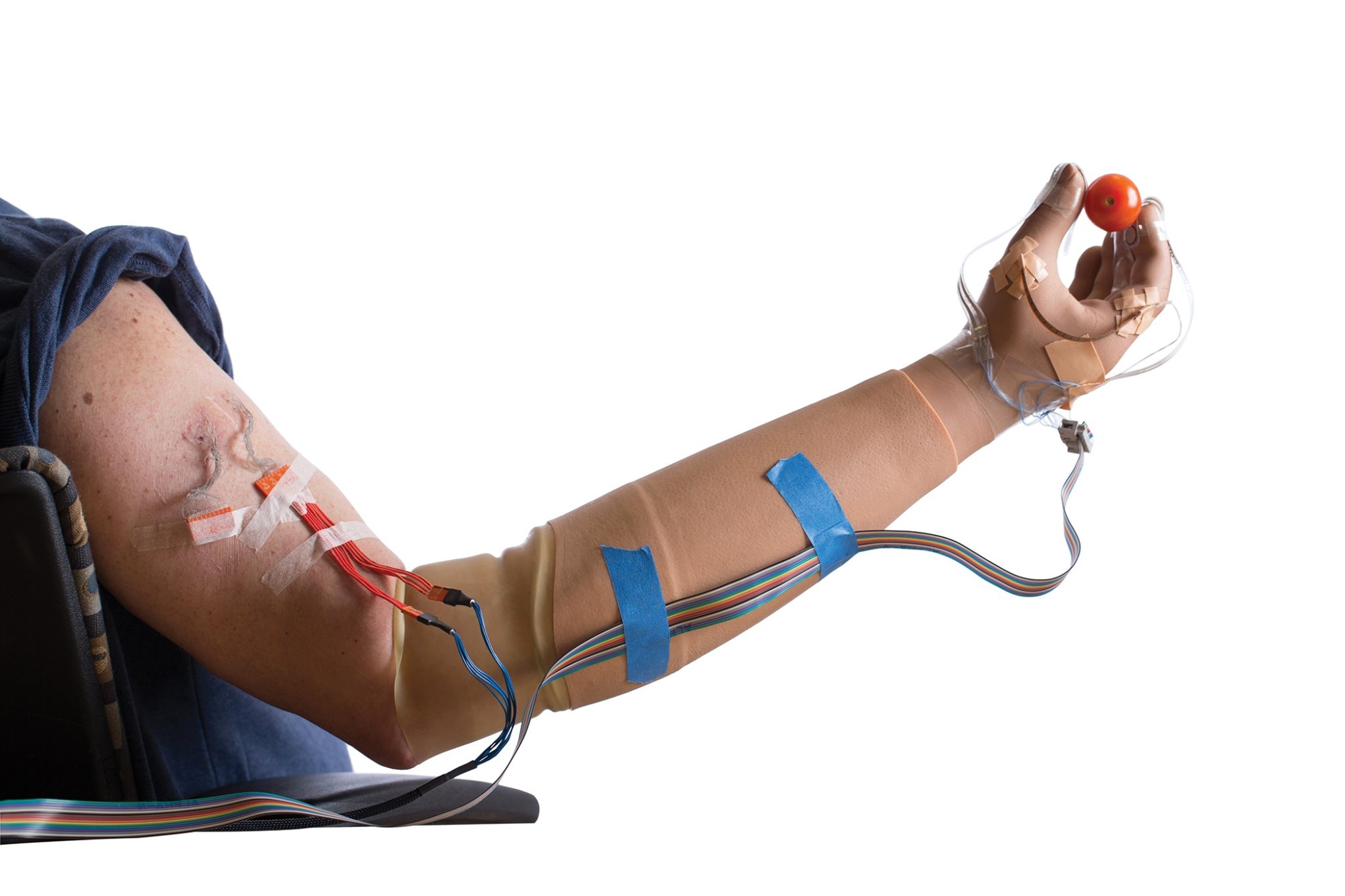

Years after they had lost parts of their arms in industrial accidents, Igor Spetic and Keith Vonderhuevel once again felt sensations — such as the fuzz of a cotton ball, or a trickle of water — seemingly on the backs of their prosthetic hands. The touches were lab-created, done as part of a study on how to electronically re-create touch for people who have lost their hands.
The study, published yesterday, is the first to create such natural-feeling sensations artificially. “I knew immediately it was cotton,” Spetic said in a statement. Cotton balls, he explained, used to give him goosebumps; he said he used to make his family open pill bottles for him to avoid them. This sensation gave him goosebumps as well.
Other groups of researchers have tried to re-create a sense of touch for amputees by buzzing their nerves with electricity… but study volunteers have always reported the resulting sensation was weird, like the pins-and-needles feeling you get when your foot falls asleep. It was as if those old experiments weren’t speaking to the brain in the right language, says Dustin Tyler, a bioengineer at Case Western University and the lead researcher in the study involving Vonderhuevel and Spetic. “We’re beginning to speak the right language now.”
Tyler and his colleagues’ study is a step toward creating prosthetic hands and arms that convey a natural sense of touch to their users. Engineers are still a long way from making a true feeling prosthetic hand, and there’s no guarantee one will ever work. Feeling prosthetics are a hot field of study, however, because they could make everyday tasks so much easier for people with prosthetics.

So how do you give a man without a hand feelings in his hand? It requires a bit of a commitment, on the study volunteer’s part. Spetic and Vonderhuevel both had to receive surgical implants of arrays with more than a dozen electrodes in their arms. At one end, the electrodes surround major bundles of nerves in their arms. At the other end, the arrays lead to a little plug on the surface of their upper arm, which is necessary for the research process. It’s like having a permanent catheter, like those that chemotherapy patients have. Hopefully, in the future, such implants will work wirelessly.
Most of the time, Vonderhuevel and Spetic’s implants don’t do much for them. Instead, they use their regular, commercially available, non-feeling prosthetics, just like any other prosthetic user does. But once or twice a month, they visit Tyler’s lab to test the electrodes’ ability to give them feelings. In lab, researchers plug their own device into the implant to send little electrical buzzes to the volunteers’ nerves.
Tyler and his colleagues have been testing which electrical patterns are best to create natural-feeling sensations. Each buzz they send is less powerful than the electric shock you might accidentally give your cat sometimes while petting it. Tyler and his colleagues aim to keep the intensities low, which Tyler thinks helps the sensations feel more natural. “We only interact with the nerve as much as the nerve is happy to interact,” he says.
“The brain doesn’t know we cheated it.”
Although the electricity is technically coming in through Spetic and Vonderhuevel’s upper arms, they report that the sensations seem to originate in their prosthetic hands. “If we get it correct, the brain interprets it that it’s coming from the hand in the first place,” Tyler says. “The brain doesn’t know we cheated it.”
Different intensities and patterns of buzzes can create different overall sensations, such as that cotton ball, or the stream of water.
In a little demonstration of how sensation like this might be helpful in the future, Vonderhuevel and Spetic participated in an experiment in which they wore an experiment prosthetic hand equipped with sensors. The hand plugged into their implants. The men tried taking the stems off cherries and grapes — a delicate task.
Blindfolded, with their implants turned off, they were able to pluck cherry stems 43 percent of the time. When researchers turned the implants on, the volunteers’ success rate shot up to 77 percent. “That’s a very nice, practical demonstration that their sensor prostheses could help someone if they had it in a clinical device,” says Joseph O’Doherty, a bioengineer at the University of California, San Francisco, who was not involved in the study.
“When the sensation’s on, it’s not too hard,” Vonderhuevel said. “When it’s off, you make a lot of grape juice.”
Despite the research’s success, there’s always the risk that the implanted array will damage their nerves or that their catheter-like site could get infected. It seems things have gone well so far, however. The men have camped and chopped wood after getting their implants. Vonderhuevel has had his implant for 16 months. Spetic has had his for two years. If all goes well, they will wear their implants for the rest of their lives.
